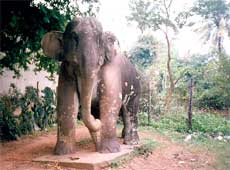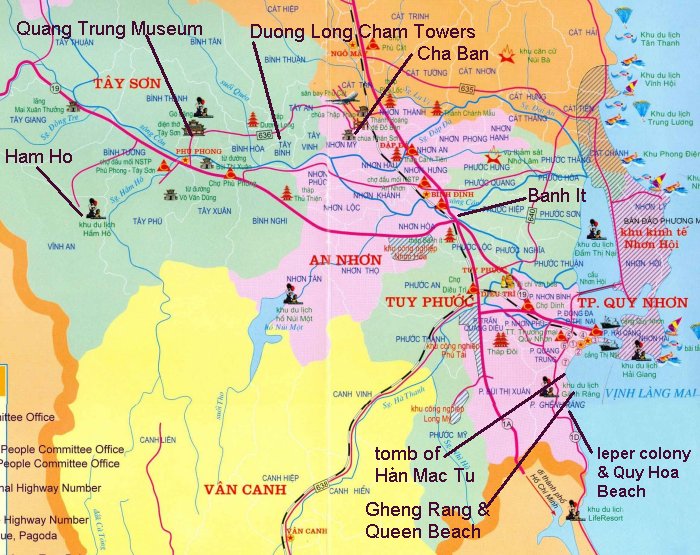 |
||||
|
Project Vietnam Trip
to Binh Dinh Province 7-13 Nov 2009 Area around Qui Nhon Cha Ban Cha Ban, which served as the seat of the royal government of Champa from the year 1000 (after the loss of Indrapura, also known as Dong Duong) until 1471, was attached and plundered repeatedly by the Vietnamese, Khmer and Chinese. In 1044, the Vietnamese prince Pha Ma occupied the city and carried off a great deal of booty as well as the Cham king’s wives, harem and female dancers, musicians and singers. Cha Ban was under the control of a Khmer overseer from 1190 to 1220. In 1377, the Vietnamese were defeated and their king was killed in an attempt to capture Cha Ban. The Vietnamese emperor Le Thanh Ton breached the eastern gate of the city in 1471 and captured the Cham king and 50 members of the royal family. During this, the last great battle fought by the Cham, 60,000 Cham were killed and 30,000 more were taken prisoner by the Vietnamese. During the Tay Son Rebellion, Cha Ban served as the capital of the central Vietnam region, and was ruled by the eldest of the three Tay Son Brothers. The capital was attached in 1793 by the forces of Nguyen Anh (later Emperor Gia Long), but the assault failed. In 1799, the orces of Nguyen Anh, under the command of Genral Vu Tinh, laid siege tot eh city and captured it. The Tay Son soon reoccupied the port of Thi Nai (modern-day Qui Nhon) and then lay siege to Cha Ban themselves. The siege continued for over a year, and by Juen 1801, Vu Tinh’s provisions were gone. Food was in short supply; all the horses and elephants had long before been eaten. Refusing to consider the ignominy of surrender, Vu Tinh had an octagonal wooden tower constructed . hefilled it with gunpowder and, arrayed in hisceremonial robes, went inside and blew himself up. Upon hear the news of the death of his dedicated general, Nguyen Anh wept.
Banh It Tower The Main Tower is 22m in height. The architecture of Banh It Towers bears the Binh Dinh sculptural style of 12th century with small, embossed lines on the walls. Leaf- and flower-shaped motifs are only found on edges of the roofs, and dancing senses are found on false gates. Carvings of dancing girls and many valuable sculptures such as the stone statue of Siva, statue of Ganesa, statue of goddess Uma, and bronze statue of Bhahma, were discovered here in the French domination period (and brought to France). The Banh It Tower has got specific architectural characteristics and is one of the great temple-towers of the Champa Dynasty, which draw the attention of researchers. Location: Located at the high hill in Dai Loc Hamlet, Phuoc Hiep Commune, Tuy Phuoc District and 25km from Qui Nhon City.
Duong Long Cham Towers The towers body is built of bricks. The corners have got motifs with stone carvings of sacred animals such as Garuda birds, elephants, and eagles. Its gate faces the east and is rather high (about 1.5m) and the gates frame is made of big stones. Its upper part is built of big stones, which are skilfully superimposed on each other. Many big, body leaf-shaped bas embossments describing monks, dancers and singers are found on the walls. These figures with rather big heads wear corner hats. Especially, the top of the tower looks like a great lotus with its rising petals. All the decorative motifs of the tower are very big and carved on sandstone. They are well-preserved. This tower complex is one of the most beautiful in Central Vietnam. This tower complex is one of the most beautiful in Central Vietnam. Location: Duong Long Cham Tower is located at Go Dang, Binh Hoa Commune, Tay Son District, Binh Dinh Province. Located 40km from Quy Nhon.
Quang Trung Museum During his reign, Quang Trung was something of a social reformer. He encouraged land reform, revised the system of taxation, improved the army and emphasized education, opening many schools and encouraging the development of Vietnamese poetry and literature. Indeed, communist literature often portrays him as a the leader of a peasant revolution whose progressive policies were crushed by the reactionary Nguyen dynasty, which to power in 1802 and was overthrown by Ho Chi Minh in 1945. The Quang Trung Museum (admission 10,000d), 48 km from Qui Nhon, displays various statues, costumes, documents and artifacts from the 18th century, most of them labeled in English. Especially notable are the elephant skin-wrapped battle drums and gongs from the Bahnar tribal people in Gia Lai province. The museum is also known for its demonstrations of vo binh dinh, a traditional martial art that is performed with a bamboo stick. To get there, take National Highway 19 west towards Pleiku. The museum is about 5 km off the highway – the turn-off is sign posted) in the Tay Son district, know for the production of a wine made from sticky rice.
Vinh Son Falls Ham Ho
Photos of Binh Dinh Province
|
||||












